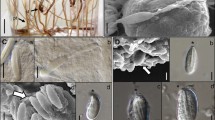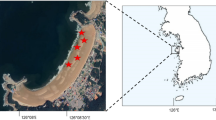Abstract
Nematocysts were extracted from 3 nudibranch species and one sea anemone species, and the ability of several test fluids to promote discharge was examined. Except when isolated in sodium citrate, nudibranch nematocysts did not discharge in response to any test fluids. Nudibranch nematocysts isolated in sodium citrate discharged when tested with EGTA, distilled water, and calcium-free artificial seawater, but there were differences among the 3 nudibranch species. Nematocysts isolated from one nudibranch species and nematocysts isolated from that nudibranch's sea anemone prey differed in the percentage that discharged in response to EGTA and distilled water. These results suggest that nematocysts stored by nudibranchs are altered in some way, resulting in the different discharge responses.
Similar content being viewed by others
References
Blanquet R. 1970. Ionic effects on discharge of the isolated and in situ nematocysts of the sea anemone Aiptasia pallida: a possible role of calcium. Comp. Biochem. Physiol. 35: 451–461.
Conklin, E. J. & R. N. Mariscal, 1977. Feeding behavior, ceras structure, and nematocyst storage in the aeolid nudibranch, Spurilla neapolitana (Mollusca). Bull. mar. Sci. 27: 658–667.
Day, R. M. & L. G. Harris, 1978. Selection and turnover of coelenterate nematocysts in some aeolid nudibranchs. Veliger 21: 104–109.
Greenwood, P. G. 1987. Nematocyst maintenance and orientation in aeolid nudibranchs. Ph.D. thesis, Florida State Univ., Tallahassee.
Greenwood, P. G. 1988. Nudibranch nematocysts. In D. A. Hessinger & H. M. Lenhoff (eds). The Biology of Nematocysts. Academic Press, N.Y.: 445–462.
Greenwood, P. G. & R. N. Mariscal, 1984. The utilization of cnidarian nematocysts by aeolid nudibranchs: nematocyst maintenance and release in Spurilla. Tissue Cell 16: 719–730.
Gupta, B. C. & T. A. Hall, 1984. Role of high concentration of Ca, Cu, and Zn in the maturation and discharge in situ of sea anemone nematocysts as shown by x-ray microanalysis of cryosections. In L. Bolis, J. Zadunaisky & R. Gilles (eds), Toxins, Drugs and Pollutants in Marine Animals. Springer-Verlag, Berlin: 77–95.
Harris, L. G., 1973. Nudibranch associations. In T. C. Cheng (ed.), Current Topics in Comparative Pathobiology V. II. Academic Press, N.Y.: 213–315.
Hidaka, M. & R. N. Mariscal, 1988. Effects of ions on nematocysts isolated from acontia of the sea anemone Calliactis tricolor by different methods. J. exp. Biol. 136: 23–34.
Lubbock, R. & W. B. Amos, 1981. Removal of bound calcium from nematocyst contents causes discharge. Nature, Lond. 290: 500–501.
Lubbock, R., B. L. Gupta & T. A. Hall, 1981. Novel role of calcium in exocytosis: Mechanisms of nematocyst discharge as shown by X-ray microanalysis. Proc. nam. Acad. Sci. U.S.A. 78: 3624–3628.
Mariscal, R. N. 1988. X-ray microanalysis and perspectives on the role of calcium and other elements in cnidae. In D. A. Hessinger & H. M. Lenhoff (eds), The Biology of Nematocysts. Academic Press, N.Y.: 95–113.
McKay, M. C. & P. A. V. Anderson, 1988. On the preparation and properties of isolated cnidocytes and cnidae. In D. A. Hessinger & H. M. Lenhoff (eds), The Biology of Nematocysts. Academic Press, N.Y.: 273–293.
Salleo, A., G. La Spada & M. Alfa, 1983. Blockage of trypsininduced discharge of nematocysts of Pelagia noctiluca by Ca2+. Molec. Physiol. 3: 89–97.
Salleo, A., G. La Spada & M. G. Denaro, 1988. Release of free Ca2+ from the nematocysts of Aiptasia mutabilis during the discharge. Physiol. Zool. 61: 272–279.
Salleo, A., G. La Spada, G. Falzea & M. G. Denaro, 1984. Discharging effect of anions and inhibitory effect of divalent cations on isolated nematocysts of Pelagia noctiluca. Molec. Physiol. 5: 25–34.
Tardent, P. 1988. History and current state of knowledge concerning discharge of cnidae. In D. A. Hessinger & H. M. Lenhoff (eds), The Biology of Nematocysts. Academic Press, N.Y.: 309–332.
Watson, G. M.& D. A. Hessinger, 1989a. Cnidocyte mechanoreceptors are tuned to the movements of swimming prey by chemoreceptors. Science, N.Y. 243: 1589–1591.
Watson, G. M. & D. A. Hessinger, 1989b. Cnidocytes and adjacent supporting cells form receptor-effector complexes in anemone tentacles. Tissue Cell 21: 17–24.
Weber, J., M. Klug & P. Tardent, 1987. Some physical and chemical properties of purified nematocysts of Hydra attenuata Pall. (Hydrozoa, Cnidaria). Comp. Biochem. Physiol. 88B: 855–862.
Zierold, K., I. Gerke & M. Schmitz, 1989. X-ray microanalysis of fast exocytotic processes. In K. Zierold & H. K. Hagler (eds), Electron Probe Microanalysis: Applications in Biology and Medicine. Springer-Verlag, Berlin: 281–292.
Author information
Authors and Affiliations
Rights and permissions
About this article
Cite this article
Greenwood, P.G., Garrity, L.K. Discharge of nematocysts isolated from aeolid nudibranchs. Hydrobiologia 216, 671–677 (1991). https://doi.org/10.1007/BF00026529
Issue Date:
DOI: https://doi.org/10.1007/BF00026529




